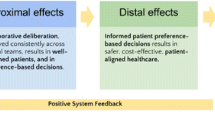Abstract
Market forces in health care have created substantial regulatory, legislative, and reimbursement changes that have had a significant impact on urology group practices. To maintain viability, many urology groups have merged into larger integrated entities. Although group operations vary considerably, the majority of groups have struggled with the development of a strong culture, effective decision-making, and consensus-building around shared resources, income, and expense. Creating a sustainable business model requires urology group leaders to allocate appropriate time and resources to address these issues in a proactive manner. This article outlines collaboration strategies for creating an effective culture, governance, and leadership, and provides practical suggestions for optimizing the performance of the urology group practice.

Similar content being viewed by others
References
Wilkins AL, Ouchi WG. Efficient cultures. Exploring the relationship between culture and organizational performance. Admin Sci Quart. 1983;28:468–81.
Schall MS. A communication-rules approach to organizational culture. Admin Sci Quart. 1983;28:557–81.
Rousseau D. Assessing organizational culture. The case for multiple methods. Scheider (ed). Climate and Culture. (San Francisco: Jossey-Bass, 1990).
Schein EH. The role of the founder in creating organizational culture. Organ Dynam. 1983;12:13–28.
Schein EH. Culture: the missing concept in organization studies. Admin Sci Quart. 1996;41(2):229–40.
Marcoulides G, Heck R. 1993. Organizational Culture and Performance: Proposing and Testing a Model. Organization Science. Published Online: May 1,1993, pp. 209–225.
Rousseau, D. Assessing organizational culture. The case for multiple methods. Scheider B (ed). Climate and Culture. San Francisco: Jossey-Bass, 1990.
Gray B. Collaborating: finding common ground for multiparty problems. San Francisco: Jossey-Bass; 1989.
Adler P, Heckscher C. Building a Collaborative Enterprise, 2011 http://hbr.org/2011/07/building-a-collaborative-enterprise/ar/1
Porter ME, Thomas H. The strategy that will fix health care. Harv Bus Rev. 2013;91(10):50–70.
Compliance with Ethics Guidelines
ᅟ
Conflict of Interest
Dana L. Jacoby, Bruce S. Maller, and Lisa R. Peltier each declare no potential conflict of interest.
Human and Animal Rights and Informed Consent
This article does not contain any studies with human or animal subjects performed by any of the authors.
Author information
Authors and Affiliations
Corresponding author
Additional information
This article is part of the Topical Collection on Office Urology
Rights and permissions
About this article
Cite this article
Jacoby, D.L., Maller, B.S. & Peltier, L.R. Optimizing Urology Group Partnerships: Collaboration Strategies and Compensation Best Practices. Curr Urol Rep 15, 442 (2014). https://doi.org/10.1007/s11934-014-0442-1
Published:
DOI: https://doi.org/10.1007/s11934-014-0442-1




